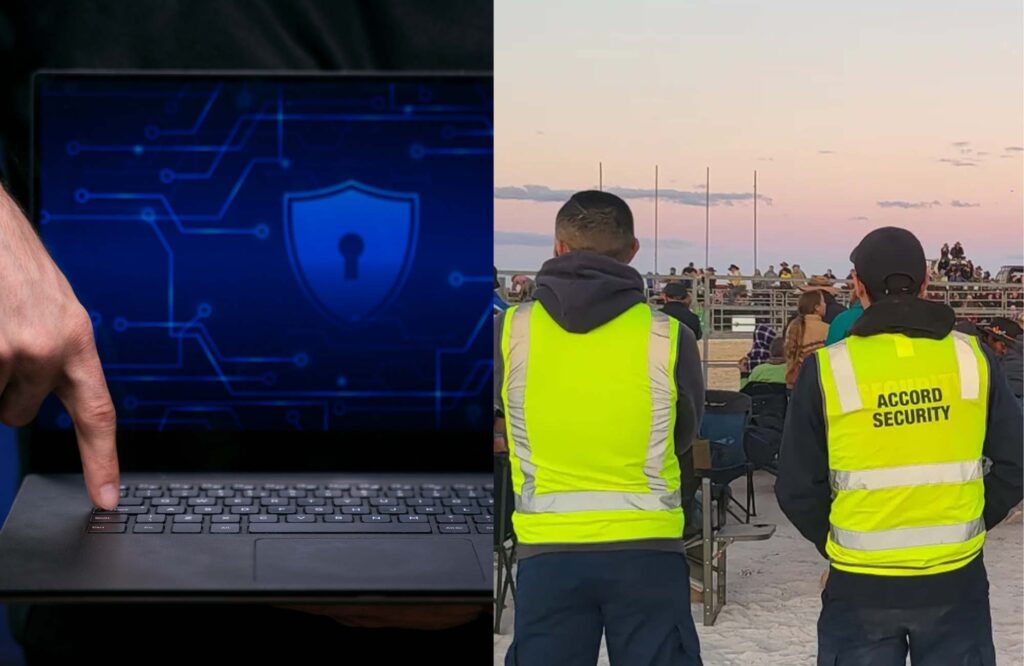Ever feel like your security strategy has blind spots? Maybe your firewalls are rock-solid, but your physical premises could use a little TLC. Or vice versa, you’ve got CCTV cameras everywhere, but your digital systems?
Well, they’re not exactly Fort Knox.
Australian businesses are increasingly vulnerable to overlapping threats that exploit gaps between cybersecurity and physical security.
Think about it: a hacker could breach your network, while a trespasser accesses critical equipment on-site. Without a unified approach, these vulnerabilities can spiral into major risks.
So, how can we bridge this gap? Let’s unpack the differences between cybersecurity vs. physical security and explore strategies to bring them together.
Cybersecurity vs. Physical Security: What’s the Difference?
- Definition: Cybersecurity involves safeguarding computers, networks, and data from unauthorised access or attacks.
- Threats: Hacking, phishing, ransomware, malware, and data breaches.
- Tools: Firewalls, antivirus software, encryption, and multi-factor authentication.
Physical Security: Protecting the Physical World
- Definition: Physical security focuses on preventing unauthorised access to physical locations or assets.
- Threats: Theft, vandalism, natural disasters, and workplace violence.
- Tools: Surveillance cameras, locks, access control systems, and security guards.
Why the Gap Between Cybersecurity and Physical Security Exists
Traditionally, cybersecurity and physical security are treated as separate entities, often managed by different teams with little collaboration.
Overlapping Vulnerabilities
The physical world and digital world are more interconnected than ever. For example, an unsecured physical server room can lead to digital breaches, while compromised cybersecurity can disable physical systems like alarms or locks.
Lack of Awareness
Many businesses underestimate the importance of integrating these security layers, leaving gaps for threats to exploit.
Bridging the Gap: Why Integration Is Crucial
Real-World Risks of Disconnection
- Cyber Attacks Exploiting Physical Gaps: Hackers could physically access a poorly secured server room to breach networks.
- Physical Threats Leveraging Cyber Weaknesses: An intruder disables digital security systems to gain access to high-value areas.
Benefits of Unified Security
- Comprehensive Protection: Addresses threats across both physical and digital realms.
- Enhanced Response Times: A unified approach ensures quicker and more effective responses.
- Cost Efficiency: Streamlining resources and strategies reduces redundancies.
Strategies for Integrating Cybersecurity and Physical Security
1. Implement IoT-Enabled Systems
Use Internet of Things (IoT) devices like smart locks and integrated alarms that connect physical and digital security.
2. Centralise Monitoring
Adopt platforms that provide a single dashboard for managing both cybersecurity and physical security systems.
3. Train Employees
Educate staff on the intersection of physical and digital security. For example, employees should know not to share access codes or leave sensitive documents unsecured.
4. Conduct Joint Risk Assessments
Collaborate across teams to identify vulnerabilities in both cybersecurity and physical security, addressing gaps holistically.
5. Partner with Security Experts
Engaging professionals like Accord Security ensures access to cutting-edge solutions tailored to Australian businesses.
Emerging Trends in Security Integration
Artificial Intelligence (AI)
AI tools can analyse data from surveillance footage and network traffic to detect anomalies in real-time.
Biometrics
Biometric systems, such as fingerprint scanners, blend cybersecurity and physical security for robust access control.
Cloud-Based Security
Cloud platforms centralise data, enabling seamless management of physical and digital security from any location.
Moving Forward: Unified Security for a Safer Tomorrow
The battle of cybersecurity vs. physical security isn’t about choosing one over the other, it’s about finding harmony. Australian businesses face modern threats that demand a seamless blend of both strategies. From IoT integrations to professional guidance, the solutions are within reach.
Is your business prepared to tackle these challenges head-on? Don’t leave it to chance. With Accord Security, you can discover how integrated security can safeguard your future.
FAQs
1. Why is integrating cybersecurity and physical security important?
Integration ensures comprehensive protection by addressing vulnerabilities in both physical and digital realms, preventing overlap or gaps.
2. Can IoT devices enhance security?
Yes, IoT devices enable real-time monitoring and control, making it easier to secure both physical spaces and digital networks.
3. What are common threats that exploit both types of security?
Examples include cyberattacks targeting physical systems like alarms or intrusions that exploit digital weaknesses to access sensitive areas.
4. How can businesses start bridging the gap?
Begin with a risk assessment to identify vulnerabilities and implement integrated solutions, such as IoT systems or centralised monitoring platforms.
5. Are biometric systems secure?
Biometric systems are highly secure but should be paired with cybersecurity measures to prevent potential hacking.
